When it comes to culinary herbs and vegetables, celery, cilantro, and parsley often find themselves in the same category. However, these three ingredients possess distinct flavors, appearances, and uses. Let's dive into what sets celery, cilantro, and parsley apart, as explained by experts in the field.
1. Celery: The Crunchy and Versatile Vegetable
- Flavor and Aroma: Celery boasts a crisp and slightly salty flavor, coupled with a mild earthy aroma.
- Appearance: Long, pale green stalks with segmented ribs and leaves on top.
- Culinary Uses: Adds texture and flavor to soups, stews, salads, and even as a snack.
- Nutritional Value: Low in calories, high in fiber, vitamins (K, A), and antioxidants.
2. Cilantro: The Herb with a Bold Twist
- Flavor and Aroma: Cilantro offers a vibrant and citrusy flavor with a hint of peppery spiciness.
- Appearance: Delicate, feather-like leaves, often used as a garnish.
- Culinary Uses: Common in Mexican, Indian, and Asian dishes, adding freshness and zing.
- Nutritional Value: Rich in vitamins (K, A, C), minerals, and antioxidants.
3. Parsley: More Than Just a Garnish
- Flavor and Aroma: Parsley presents a balanced flavor with a slight hint of bitterness and a fresh, herbal aroma.
- Appearance: Flat or curly leaves with a bright green hue.
- Culinary Uses: Enhances the taste and presentation of various dishes, from sauces to salads.
- Nutritional Value: Packed with vitamins (K, C), minerals, and compounds with potential health benefits.
4. Expert Insights: What Sets Them Apart?
- Celery: Noted for its crunchy texture and subtle salty taste, celery adds depth to broths and provides a satisfying crunch in salads.
- Cilantro: Renowned for its polarizing nature—some love it, some dislike it—cilantro lends a unique flavor profile to diverse cuisines.
- Parsley: Appreciated for its versatility, parsley contributes a mild herbaceous taste that complements a wide range of dishes.
5. Using the Right Herb for the Right Dish
- Balancing Flavors: Choose celery for adding a light crunch and mild flavor to soups and stocks.
- Brightening Dishes: Opt for cilantro to add a burst of freshness to salsas, curries, and guacamole.
- Adding Depth: Utilize parsley to enhance the overall taste of sauces, marinades, and Mediterranean dishes.
6. Embracing the Differences: Why It Matters
- Culinary Creativity: Understanding the unique characteristics of these herbs empowers chefs to create well-balanced and intriguing dishes.
- Cultural Significance: The specific use of each herb in various cuisines reflects the cultural preferences and regional culinary traditions.
- Nutritional Benefits: Incorporating a variety of herbs like celery, cilantro, and parsley offers a range of nutrients that contribute to a wholesome diet.
In the realm of culinary exploration, celery, cilantro, and parsley stand as distinct flavor enhancers, each contributing its own signature taste to dishes from around the world. By recognizing their individual attributes, we can embark on a flavorful journey of creativity and nourishment.
Natural Home Remedies for Kidney Stone Prevention
Six Easy Ways to Lose Belly Fat Without Exercise or Diet
When you travel, you frequently make financial mistakes
